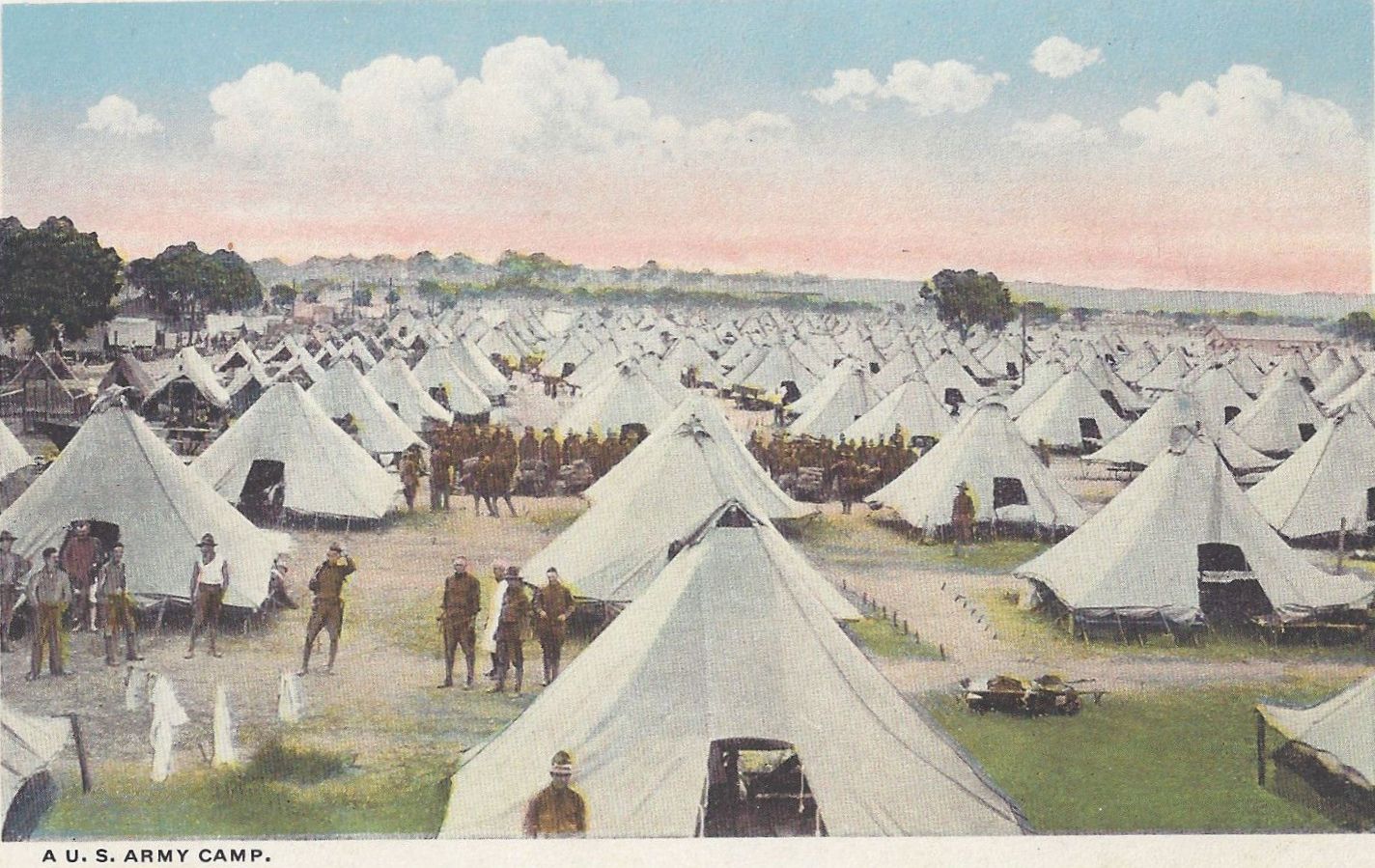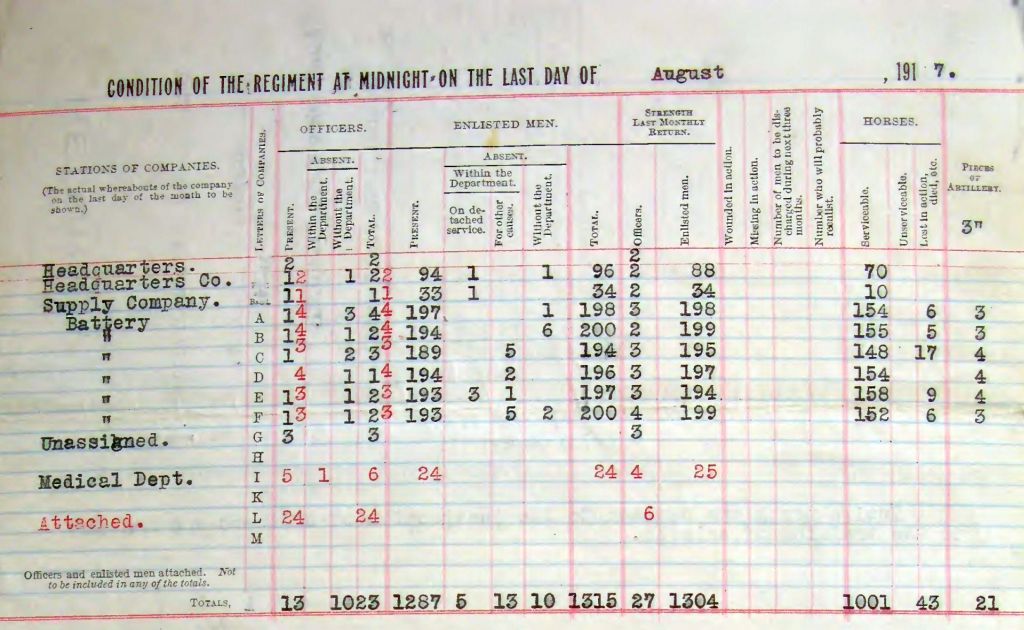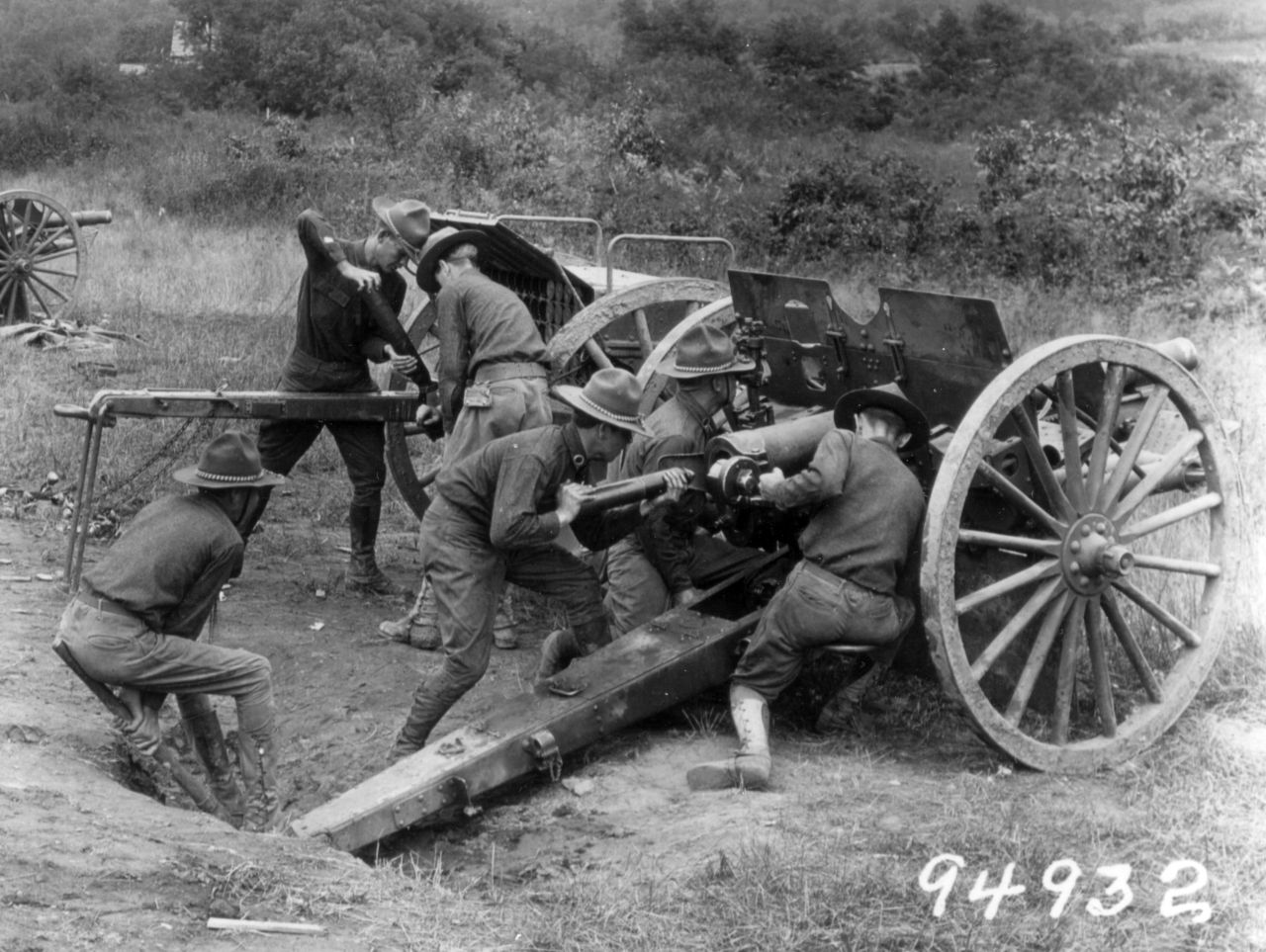The 12th Field Artillery at Camp St Asaph
The United States declared war on Germany on 6 April 1917. President Wilson had called for a million volunteers, but response was extremely disappointing and the selective service act was enacted on 18 May, with the first registrations held on 5 June for men between 21 and 30.
Regardless of how the men were to be brought in under the colors, space would clearly be needed for them, as the Army expanded from 108,399 in June 1916 to 421,467 a year later, to 2,395,742 a year after that. A 45-acre open field right across the river from the Army general staff would have caught their attention. The huge abandoned wooden grandstand had burned to the ground in 1916, the flames visible in DC, and the stables a few years before that. Nothing was left except weeds, pieces of wood, mounds of earth, and a few remnants such as troughs. On 24 May 1917 the Washington Post reported that representatives of the War Department had carried out an inspection of the old race track property with an eye towards accommodating about a thousand men that would be overflow from what Ft Myer could handle.
The Army moved with uncharacteristic alacrity, signing a one-year lease on the racetrack land on 26 May 1917 for $250 a month. The leasehold was defined as being bounded on the south by Mt Ida Avenue, on the short eastern side by US 1, on the north-east by the W&OD rail line, on the north by the Frank Hume estate and on the west by the electric rail line (now Commonwealth Avenue). They excepted two pieces from the lease, one, about a half acre on the NE corner of Mt Vernon and Mt Ida that held a house, some outbuildings and garden, and a second being about 50 feet along the east side of the electric railway to a depth of about a hundred feet along Mt Ida Avenue. A second lease for a smaller lot of about nine acres was signed with Frank Hume for $43 per month, bounded on the north by Hume Avenue, on the west by Mt Vernon Avenue, on the east by the W&OD line and on the south by the main body of the Camp. This was generally known thereafter as Camp St Asaph, after the old racetrack, but was sometimes called “Camp Fort Myer” as it was a direct dependency of that larger installation.


An Army tented camp of the time, similar to Camp St Asaph
At the same time the 445 men of the II Battalion of the 3rd Field Artillery were returned to their home station of Ft Myer from the Mexican border. Once there they were directed to use two-thirds of their personnel as cadre to create a new unit, the 12th Field Artillery Regiment. In other words, about 300 men would form the framework for a 1,300-man regiment, the balance to come from new untrained draftees. The cadre tasked with forming the 12th FA arrived at the old racetrack on 25 May and, being old campaigners, had the bulk of the camp ready for occupancy in two days. The draftees to fill out the regiment arrived on 17 June and training immediately began. The regiment consisted of headquarters and support elements along with its six field artillery batteries (A – F) each to be equipped with four 3” field guns. The regiment was at full troop strength, albeit inefficient for lack of training, by the end of June, and by the end of August the horses had arrived.

This put an even 1,300 men of the 12th Regiment plus 24 attached and 29 medical personnel and 1,001 horses into the camp area. The Army has always been good at housing people quickly, not really surprising since comfort was never a high priority.

A stitched panoramic photo of Battery B, 12th Field Artillery at Camp St Asaph in 1917. A higher-resolution version can be seen here.
The YMCA and the Red Cross set up reading and recreation rooms near the camp, and the regiment reciprocated with concerts by its band. Troops with families were sometimes allowed to take rooms in the houses of local town residents. The highlight of these efforts came with a passionate speech by William Jennings Bryan in a special large tent erected in the camp in June. He spoke to about five hundred of the soldiers, condemning liquor, urging them to read good books, and imploring them to “live Christian lives”.
The former secretary of state and frequent presidential candidate was reportedly well received, although it is not clear everyone agreed with the entire content. On 24 November a car fleeing DC police crashed just outside the camp and was found to hold an estimated 450 pint bottles of whiskey. A crowd of soldiers and civilians gathered around, but by the time the Alexandria County sheriff arrived only 215 pints remained. It seems likely that Mr Bryan's exhortations notwithstanding, most of those ended up in the camp.
One of the draftees, sworn in on 25 May, was actually a Yale student and was determined to use the Mt Vernon Avenue school, directly across the street from the camp and closed for the summer, to better his fellow soldiers. As reported in the Alexandria Gazette of 18 July 1917:
A khaki-clad young man walked into the office of George W Zachary, clerk of the school board of Alexandria county, yesterday. Saluting, he said: “You have a vacant ten-room schoolhouse at Hume station, opposite the old St. Asaph track. I have come to ask you to let the soldiers use it for school rooms. We are getting up classes in French, so that we can talk the language”. “And who are you?” asked Mr Zachary. “My name is Taft; I'm a soldier” said the young man. “Son of Ex-president Taft?” “Yes, sir”. “Take the schoolhouse.” Young Taft, it is understood, is also to teach English to privates in the artillery encampment at St Asaph, several of the men realizing their need of training in their language having applied for textbooks at the YMCA headquarters in Washington. Most of the men whom Taft will teach are naturalized foreigners.
In December 1917 the regiment entrained for Camp Mills in New Jersey. The history of B Battery records that “The weather was very cold at Camp Mills but the change was welcome. At St. Asaph's we had been in tents, while at Mills we drew down billets in frame buildings equipped with quasi modern plumbing. The real charm of adequate bathing facilities can only be truly appreciated by one who either attempts to go through the motions of enjoying a brief shower while the water tries to freeze on the skin or, still worse, tries to dispense with bathing entirely.” The historian went on to note that once at Ft Mills “the appearance and spirit of the regiment rose rapidly”. Similarly, the regiment's chaplain wrote the following spring that St Asaph had been a “cold and dreary place”, leavened only by the friendliness of the locals.
The regiment spent December in New Jersey and arrived in Le Havre, via England, in late January 1918. After further training, including in the new French artillery pieces they were issued, they moved to the front in late March and fired their first combat mission on 1 April. The regiment remained in combat, on and off, for the rest of the war, including supporting the Marines at Belleau Wood.
Meanwhile, back at Camp St Asaph, only a small caretaker detachment remained. They departed in the spring of 1918 and the leases on the camp were allowed to lapse, leaving the land open for development.

A plat of Camp St Asaph, with the view of the postcard above in red, and that of the panoramic battery photo in blue. As noted before, some street names were changed by the City after annexation, with Carroll becoming Uhler, Peyton to Del Ray, and Lloyd to Custis. A higher resolution image is available here.

A 3-inch M1902 field gun of the type used for training at Camp St Asaph. The crew drills, like that shown above, would have been practiced constantly, abeit with dummy ammunition.